- 基础教程
- 条件语句
- 指针教程
- 面向对象
- STL教程
- 进阶教程

在C++中,继承是一个过程,其中一个对象自动获取其父对象的所有属性和行为。这样,您可以重用,扩展或修改在其他类中定义的属性和行为。
在C++中,继承另一个类的成员的类称为派生类,其成员被继承的类称为基类。派生类是基类的子类。
继承类型
C++支持五种继承类型:
- Single inheritance
- Multiple inheritance
- Hierarchical inheritance
- Multilevel inheritance
- Hybrid inheritance
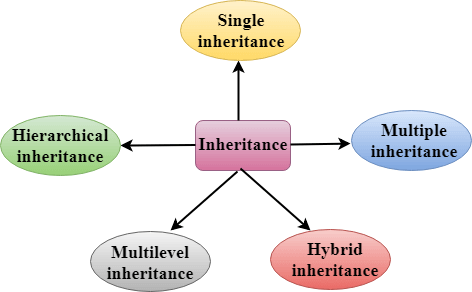
派生类
派生类定义为从基类派生的类。
class derived_class_name :: visibility-mode base_class_name { //派生类的主体。 }
derived_class_name - 这是派生类的名称。
visibility-mode - 可见性模式指定基类的函数是公共继承的还是私有继承的。它可以是公共的或私有的。
base_class_name - 这是基类的名称。
- 当基类由派生类私有继承时,基类的公共成员将成为派生类的私有成员。因此,派生类的对象不能仅通过派生类的成员函数访问基类的公共成员。
- 当派生类公开继承基类时,基类的公共成员也将成为派生类的公共成员。因此,派生类的对象以及基类的成员函数都可以访问基类的公共成员。
注意:
- 在C++中,可见性的默认模式是private私有的。
- 基类的私有成员永远不会被继承。
单一继承
单一继承定义为从唯一的一个基类继承派生类的继承。

其中" A"是基类,而" B"是派生类。
链接:https://www.learnfk.comhttps://www.learnfk.com/c++/cpp-inheritance.html
来源:LearnFk无涯教程网
单一继承示例-继承字段
当一个类继承另一类时,称为单级继承。让我们看一下仅继承字段的单级继承示例。
#include <iostream> using namespace std; class Account { public: float salary = 60000; }; class Programmer: public Account { public: float bonus = 5000; }; int main(void) { Programmer p1; cout<<"Salary: "<<p1.salary<<endl; cout<<"Bonus: "<<p1.bonus<<endl; return 0; }
输出:
Salary: 60000 Bonus: 5000
在上面的示例中,Employee是 base 类,而Programmer是派生类。
单一继承示例-继承方法
让我们看看C++中继承的另一个示例,该示例仅继承方法。
#include <iostream> using namespace std; class Animal { public: void eat() { cout<<"Eating..."<<endl; } }; class Dog: public Animal { public: void bark(){ cout<<"Barking..."; } }; int main(void) { Dog d1; d1.eat(); d1.bark(); return 0; }
输出:
Eating... Barking...
让我们看一个简单的例子。
#include <iostream> using namespace std; class A { int a = 4; int b = 5; public: int mul() { int c = a*b; return c; } }; class B : private A { public: void display() { int result = mul(); std::cout <<"Multiplication of a and b is : "<<result<< std::endl; } }; int main() { B b; b.display(); return 0; }
输出:
Multiplication of a and b is : 20
在上面的示例中,类A是私有继承的。因此,类" A"的mul()函数不能被类B的对象访问。只能由类B的成员函数访问。
继承私有成员
私有成员不可继承。如果我们通过公开公开性来修改可见性模式,但这将消除数据隐藏的优势。
C++引入了三个Visibility修饰器,即Public,Private,Protected,声明为受保护(Protected)的成员将用于该类中的所有成员函数以及从该成员派生的类中所有成员函数。
可见性模式可以分为三类:
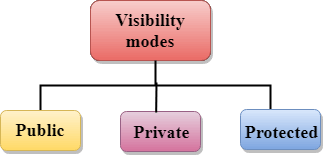
- 公开(Public) - 将该成员声明为公开成员后,该程序的所有函数都可以访问。
- 私有(Private) - 将成员声明为私有成员后,只能在该类中访问它。
- 受保护(Protected) - 将成员声明为受保护成员后,就可以在其自己的类以及从其派生的类中对其进行访问。
多层次继承
多级继承是从另一个派生类派生一个类的过程。

多级继承示例
当一个类继承另一个类又被另一个类继承时,在C++中称为多级继承。继承是可传递的,因此最后一个派生类将获取其所有基类的所有成员。
让我们看一下C++中多级继承的示例。
#include <iostream> using namespace std; class Animal { public: void eat() { cout<<"Eating..."<<endl; } }; class Dog: public Animal { public: void bark(){ cout<<"Barking..."<<endl; } }; class BabyDog: public Dog { public: void weep() { cout<<"Weeping..."; } }; int main(void) { BabyDog d1; d1.eat(); d1.bark(); d1.weep(); return 0; }
输出:
Eating... Barking... Weeping...
多重继承
多重继承是派生一个新类的过程,该类继承了两个或多个类的属性。
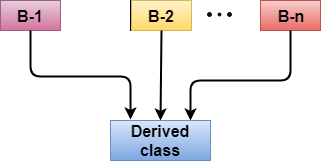
派生类的语法:
class D : visibility B-1, visibility B-2, ? { //Body of the class; }
让我们看一个简单的多重继承的例子。
#include <iostream> using namespace std; class A { protected: int a; public: void get_a(int n) { a = n; } }; class B { protected: int b; public: void get_b(int n) { b = n; } }; class C : public A,public B { public: void display() { std::cout << "The value of a is : " <<a<< std::endl; std::cout << "The value of b is : " <<b<< std::endl; cout<<"Addition of a and b is : "<<a+b; } }; int main() { C c; c.get_a(10); c.get_b(20); c.display(); return 0; }
输出:
The value of a is : 10 The value of b is : 20 Addition of a and b is : 30
在上面的示例中,类" C"在公共模式下继承了两个基类" A"和" B"。
解决继承歧义
当同一个名称的函数出现在多个基类中时,在使用多重继承时可能会产生歧义。
让我们通过一个例子来理解这一点:
#include <iostream> using namespace std; class A { public: void display() { std::cout << "Class A" << std::endl; } }; class B { public: void display() { std::cout << "Class B" << std::endl; } }; class C : public A, public B { void view() { display(); } }; int main() { C c; c.display(); return 0; }
输出:
error: reference to 'display' is ambiguous
display();
- 上述问题可以通过将类解析运算符与函数一起使用来解决。在上面的示例中,派生的类代码可以重写为:
class C : public A, public B { void view() { A :: display(); //调用类 A 的 display() 函数。 B :: display(); //调用 B 类的 display() 函数。 } };
单一继承中也可能出现歧义。
请考虑以下情况:
class A { public: void display() { cout<<?Class A?; } } ; class B { public: void display() { cout<<?Class B?; } } ;
在上述情况下,派生类的函数将覆盖基类的方法。因此,调用display()函数将只调用派生类中定义的函数。如果要调用基类函数,则可以使用类解析运算符。
int main() { B b; b.display(); //调用 B 类的 display() 函数。 b.B::display(); //调用 B 类中定义的 display() 函数。 }
混合继承
混合继承是一种以上类型的继承的组合。
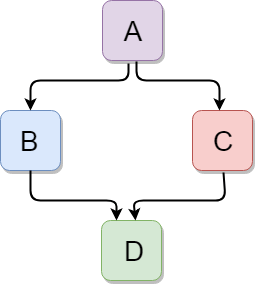
让我们看一个简单的例子:
#include <iostream> using namespace std; class A { protected: int a; public: void get_a() { std::cout << "Enter the value of 'a' : " << std::endl; cin>>a; } }; class B : public A { protected: int b; public: void get_b() { std::cout << "Enter the value of 'b' : " << std::endl; cin>>b; } }; class C { protected: int c; public: void get_c() { std::cout << "Enter the value of c is : " << std::endl; cin>>c; } }; class D : public B, public C { protected: int d; public: void mul() { get_a(); get_b(); get_c(); std::cout << "Multiplication of a,b,c is : " <<a*b*c<< std::endl; } }; int main() { D d; d.mul(); return 0; }
输出:
Enter the value of 'a' : 10 Enter the value of 'b' : 20 Enter the value of c is : 30 Multiplication of a,b,c is : 6000
层次继承
层次继承定义为从基类派生多个类的过程。
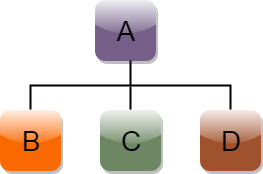
分层继承的语法:
class A { //body of the class A. } class B : public A { //body of class B. } class C : public A { //body of class C. } class D : public A { //body of class D. }
让我们看一个简单的例子:
#include <iostream> using namespace std; class Shape //基类声明。 { public: int a; int b; void get_data(int n,int m) { a= n; b = m; } }; class Rectangle : public Shape //继承 Shape 类 { public: int rect_area() { int result = a*b; return result; } }; class Triangle : public Shape //继承 Shape 类 { public: int triangle_area() { float result = 0.5*a*b; return result; } }; int main() { Rectangle r; Triangle t; int length,breadth,base,height; std::cout << "Enter the length and breadth of a rectangle: " << std::endl; cin>>length>>breadth; r.get_data(length,breadth); int m = r.rect_area(); std::cout << "Area of the rectangle is : " <<m<< std::endl; std::cout << "Enter the base and height of the triangle: " << std::endl; cin>>base>>height; t.get_data(base,height); float n = t.triangle_area(); std::cout <<"Area of the triangle is : " << n<<std::endl; return 0; }
输出:
Enter the length and breadth of a rectangle: 23 20 Area of the rectangle is : 460 Enter the base and height of the triangle: 2 5 Area of the triangle is : 5
祝学习愉快!(内容编辑有误?请选中要编辑内容 -> 右键 -> 修改 -> 提交!)
 《C++入门教程》
《C++入门教程》 